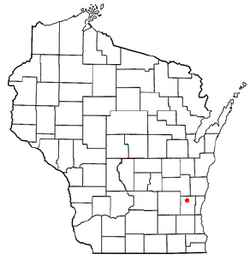Barton, Wisconsin facts for kids
Quick facts for kids
Barton, Wisconsin
|
|
|---|---|

Town hall
|
|

Location of Barton, Wisconsin
|
|
| Country | |
| State | |
| County | Washington |
| Incorporated | 1848 |
| Area | |
| • Total | 19.5 sq mi (50.4 km2) |
| • Land | 19.2 sq mi (49.8 km2) |
| • Water | 0.2 sq mi (0.6 km2) |
| Elevation | 1,030 ft (314 m) |
| Population
(2000)
|
|
| • Total | 2,546 |
| • Density | 132.5/sq mi (51.2/km2) |
| Time zone | UTC-6 (Central (CST)) |
| • Summer (DST) | UTC-5 (CDT) |
| Area code(s) | 262 |
| FIPS code | 55-05050 |
| GNIS feature ID | 1582759 |
Barton is a town located in Washington County, Wisconsin, in the United States. In the year 2000, about 2,546 people lived here. A small community called Young America is also part of the town of Barton.
Contents
History of Barton
The story of Barton began in 1845. A land surveyor named Barton Salisbury came from Mequon. He saw that the fast-moving water (rapids) on the Milwaukee River could be used to create power. This power could run machines.
Early Settlement and Mills
Salisbury built a sawmill, which cuts wood into lumber. Soon, other people moved to the area. At first, they called the place Salisbury's Mills. Salisbury later helped start the Village of Newburg. He sadly died in an accident in 1849.
In 1848, the state government created the Town of Newark. This land used to be part of the Town of West Bend. Then, in 1853, the leaders of Washington County changed the name. They decided to call it the Town of Barton, to honor Barton Salisbury.
Many sawmills and gristmills (which grind grain into flour) were built along the river. By 1855, over 1,000 people lived in Barton. This made it bigger than its neighbor, West Bend, at the time.
Community and Churches
Most of the first settlers were farmers from Germany. They came to live and work the land. The first church in Barton was a German Methodist church, started in 1850. In 1852, other settlers who were not German started the Presbyterian Society of Newark.
The first Roman Catholic church service in Barton was held on Christmas Day, 1857. On August 12, 1858, a missionary named Father Caspar Rehrl started a group called the Roman Catholic Congregation of Sisters of St. Agnes in Barton. He also built the historic St. Agnes Convent and School. In their early years, these sisters focused on teaching. They worked in schools in Barton and nearby areas.
Changes Over Time
In April 1925, a part of the town's land became its own separate area called the Village of Barton. People in the Town of Barton voted on this idea. Most people voted yes.
Later, on September 12, 1961, another vote happened. This time, people in the Village of Barton and the City of West Bend voted. They wanted to decide if the village should join the city. Most people in both places voted yes. So, the Village of Barton officially became part of the City of West Bend on November 1, 1961.
Today, much of the land in the Town of Barton is still used for farming.
Geography
Barton covers an area of about 19.5 square miles (50.4 square kilometers). Most of this area, about 19.2 square miles (49.8 square kilometers), is land. The rest, about 0.2 square miles (0.6 square kilometers), is water.
People in Barton (Demographics)
Based on the 2000 census, 2,546 people lived in Barton. There were 896 households, which are groups of people living together in one home. Most households, 74.4%, were married couples. About 36% of households had children under 18 living with them.
The average household had about 2.84 people. The average family had about 3.12 people.
Population Age and Income
The population in Barton was spread out by age:
- About 25.7% were under 18 years old.
- About 7.1% were between 18 and 24.
- About 27.8% were between 25 and 44.
- About 31.3% were between 45 and 64.
- About 8.1% were 65 years or older.
The average age of people in Barton was 40 years. For every 100 females, there were about 110.9 males.
The average income for a household in Barton was about $64,861 per year. For families, the average income was about $69,730. Very few people, about 1.7% of the population, were living with very low incomes.
Notable People
Here are some well-known people who have connections to Barton:
- William Caldwell: A politician who served as a representative in the first Wisconsin Legislature.
- Joseph W. Holehouse: A politician who was a Wisconsin State Representative.
- James R. Lewis: A religious speaker and businessman. He was a politician who was removed from his position.
See also
 In Spanish: Barton (Wisconsin) para niños
In Spanish: Barton (Wisconsin) para niños

